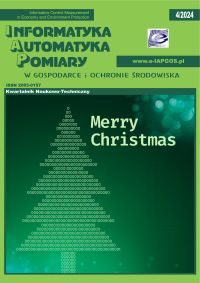ZALEŻNOŚĆ CZĘSTOTLIWOŚCIOWA NAPIĘCIOWEGO WSPÓŁCZYNNIKA MAGNETOELEKTRYCZNEGO W CERAMIKACH (BiFeO3)x-(BaTiO3)1-x
Tomasz Pikula
t.pikula@pollub.plPolitechnika Lubelska, Instytut Elektroniki i Technik Informacyjnych, Zakład Elektroniki i Fizyki Technicznej (Polska)
Karol Kowal
Narodowe Centrum Badań Jądrowych, Departament Energii Jądrowej, Zakład Energetyki Jądrowej (Polska)
Piotr Guzdek
Instytut Technologii Elektronowej, Oddział w Krakowie, Zakład Mikroelektroniki (Polska)
Abstrakt
Zależność właściwości magnetoelektrycznych od składu chemicznego w ceramikach (BiFeO3)x-(BaTiO3)1-x została w ostatnim czasie zaobserwowana i odnotowana w literaturze. Pomiary efektu magnetoelektrycznego (ME) w tych materiałach wykonywane były metodą dynamiczną. Próbki o x = 0,9, 0,8 i 0,7 umieszczano w stałym (DC) polu magnetycznym generowanym przez elektromagnes, na które nałożono zmienne (AC) pole magnetyczne o częstotliwości f = 1kHz wytwarzane przez cewki Helmholtza. W niniejszej pracy przedstawiono podstawy teoretyczne tego rodzaju pomiarów oraz wyznaczono optymalną częstotliwość pola AC, która minimalizuje procesy powodujące redukcję mierzonego sygnału napięciowego.
Słowa kluczowe:
multiferroiki, efekt magnetoelektryczny (ME), materiały magnetoelektryczne, napięciowy współczynnik magnetoelektryczny, dynamiczna metoda pomiaru, lock-inBibliografia
Duong G. V., et al.: The lock-in technique for studying magnetoelectric effect. Journal of Magnetism and Magnetic Materials 316, 2/2007, 390–393.
Google Scholar
Eerenstein W., Mathur N. D., Scott J. F.: Multiferroic and magnetoelectric materials. Nature 442, 17/2006, 759–765.
Google Scholar
Fiebig M.: Revival of the magnetoelectric effect. Journal of Physics D: Applied Physics 38, 8/2005, R123–R152.
Google Scholar
Kleemann W., Borisov P.: Multiferroic and magnetoelectric materials for spintronics w Smart Materials for Energy, Communications and Security. red. Luk’yanchuk A., Mezzane D., Springer, Dordrecht 2008.
Google Scholar
Kowal K., Jartych E., Guzdek P., Stoch P., Wodecka-Duś B., Lisińska-Czekaj A., Czekaj D.: X-ray diffraction, Mossbauer spectroscopy, and magnetoelectric effect studies of (BiFeO3)x-(BaTiO3)1-x solid solutions. Nukleonika 58, 1/2013, 57–61.
Google Scholar
Kowal K., Kowalczyk M., Czekaj D., Jartych E.: Structure and some magnetic properties of (BiFeO3)x–(BaTiO3)1-x solid solutions prepared by solid-state sintering. Nukleonika, w druku.
Google Scholar
Krotov S. S., Lisnyak A. V.: Development of the thermodynamic theory for the linear magnetoelectric effect in Cr2O3 antiferromagnet. Doklady Physics 46, 11/2001, 777–779.
Google Scholar
Kumar M., et al.: An experimental setup for dynamic measurement of magnetoelectric effect. Bulletin of Materials Science 21, 3/1998, 251–255.
Google Scholar
Park T., et al.: Composition-dependent magnetic properties of BiFeO3-BaTiO3 solid solution nanostructures. Physical Review B 82, 2/2010, 024431/1–10.
Google Scholar
Priya S., et al.: Recent advancements in magnetoelectric particulate and laminate composites. Journal of Electroceramics 19, 2007, 147–164.
Google Scholar
Ravinski A., et al.: Magnetyczno-dielektryczne właściwości polikrystalicznej ceramiki GdxBi1-xFeO3. Materiały Ceramiczne 63, 3/2011, 495–498.
Google Scholar
Rivera J. P.: A short review of the magnetoelectric effect and related experimental techniques on single phase (multi-) ferroics. The European Physical Journal B 71, 3/2009, 299–313.
Google Scholar
Rivera J. P.: On definitions, units, measurements, tensor forms of the linear magnetoelectric effect and on a new dynamic method applied to Cr-Cl boracite. Ferroelectrics 161, 1/1994, 165–180.
Google Scholar
Salje E.: Ferroelastic Materials. Annual Review of Materials Research 42, 7/2012, 265–283.
Google Scholar
Shi Z., Wang C., Liu X., Nan C.: A four-state memory cell based on magnetoelectric composite. Chinese Science Bulletin 53, 14/2008, 2135–2138.
Google Scholar
Singh R. S., et al.: Dielectric and magnetoelectric properties of Bi5FeTi3O15. Solid State Communications 91, 7/1994, 567–569.
Google Scholar
Stoch A., et al.: Właściwości magnetoelektryczne roztworu stałego 0,5Bi0,95Dy0,05FeO3-0,5Pb(Fe2/3W1/3)O3. Materiały Ceramiczne 64, 4/2012, 443–446.
Google Scholar
Zvezdin A. K., Logginov A. S., Meshkov G. A., Pyatakov A. P.: Multiferroics: promising materials for microelectronics, spintronics, and sensor technique. Bulletin of the Russian Academy of Sciences: Physics 71, 11/2007, 1561–1562.
Google Scholar
Autorzy
Tomasz Pikulat.pikula@pollub.pl
Politechnika Lubelska, Instytut Elektroniki i Technik Informacyjnych, Zakład Elektroniki i Fizyki Technicznej Polska
Autorzy
Karol KowalNarodowe Centrum Badań Jądrowych, Departament Energii Jądrowej, Zakład Energetyki Jądrowej Polska
Autorzy
Piotr GuzdekInstytut Technologii Elektronowej, Oddział w Krakowie, Zakład Mikroelektroniki Polska
Statystyki
Abstract views: 208PDF downloads: 77
Licencja

Utwór dostępny jest na licencji Creative Commons Uznanie autorstwa – Na tych samych warunkach 4.0 Miedzynarodowe.
Inne teksty tego samego autora
- Karol Kowal, Mieczysław Borysiewicz, ANALIZA NIEZAWODNOŚCI SYSTEMU ZABEZPIECZENIA REAKTORA TYPU PWR , Informatyka, Automatyka, Pomiary w Gospodarce i Ochronie Środowiska: Tom 5 Nr 1 (2015)
- Mieczysław Józef Borysiewicz, Karol Kowal, Piotr Andrzej Prusiński, Marcin Dąbrowski, ZASTOSOWANIE IRIDM W PROCESIE DECYZYJNYM DOTYCZĄCYM KONWERSJI PALIWA W REAKTORZE MARIA , Informatyka, Automatyka, Pomiary w Gospodarce i Ochronie Środowiska: Tom 3 Nr 3 (2013)
- Mieczysław Józef Borysiewicz, Karol Kowal, Piotr Prusiński, Marcin Dąbrowski, ZINTEGROWANY PROCES DECYZYJNY UWZGLĘDNIAJĄCY RYZYKO W PRZEMYŚLE JĄDROWYM , Informatyka, Automatyka, Pomiary w Gospodarce i Ochronie Środowiska: Tom 3 Nr 2 (2013)
- Karol Kowal, Mieczysław Borysiewicz, ANALIZA NIEZAWODNOŚCI AWARYJNEGO ODBIORU CIEPŁA POWYŁĄCZENIOWEGO W REAKTORZE TYPU PWR , Informatyka, Automatyka, Pomiary w Gospodarce i Ochronie Środowiska: Tom 5 Nr 3 (2015)








